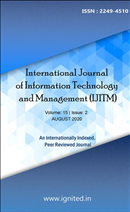A study on E-Marketing and consumer derision marking with agricultural Marketing
Main Article Content
Authors
Abstract
The evolution of human society, improvement in communication processes, and As the Internetcontinues to play an increasingly important part in consumer decision-making, digital convergence haspresented marketing with new possibilities and difficulties.This study explores e-marketing, consumerbehavior, consumer decision making process, online marketing, agricultural marketing, agriculturalmarketing scope subject Agricultural marketing issues and problems.
Downloads
Download data is not yet available.
Article Details
Section
Articles
References
- Mc Corriston, Steve and Sheldon, Ian M, Vertical Restraints and Competition Policy in the US and UK Food Marketing Systems. Agribusiness(1986-1998); Mar/Apr 1997;13,2; Pro Quest Centralpg.237
- Chandrashekar,. P. and Schary B., “Towards the virtual supply chain: the convergence of IT and organization”, International Journal of Logistic Management, Vol.10,No.2, (1999),pp.27-39.
- Acharya, S. S, ‘Agricultural Marketing in India: Some Facts and Emerging Issues’: Indian Journal ofAgriculturalEconomicsVol.No.53,1998.
- Acharya S.S., Agricultural Marketing in India: Millennium Study of Indian Farmers, Volume17, (New Delhi: Government of India, Academic Foundation, 2004).
- Acharya S. S, , “Regulation of Agricultural Produce Markets: Some Observations on its Impact”, Developmen tPolicy and Administration Review,Vol.11,No.2,(July-December,1985).
- Acharya S.S, Agricultural Production, Marketing and Price Policy in India, (New Delhi: Mittal Publications),p. 317.
- Agarwal N. L. and Meena, B. L. “Agricultural Marketing in India: Performance of Cumin Marketing in Rajasthan”, Bihar Journal of Agricultural Marketing, Vol. 5, No. 3, (September-December, 1997) pp.319-328.
- Agri wise is the way to be, Report on the Economic Times Food Strategy Summit, Agro vision 2025 held in April 2013 published in the economic times Mumbaion 2nd April 2013
- Brown Colinand Waldron Scott and Longworth, John, Specialty products, rural lively hoods andagri cultural marketing reforms in China, China Agricultural Economic Review Vol. 3 No. 2, 2011 pp.224-244q Emerald Group Publishing Limited, Australia1756-137XDOI10.1108/17561371111131335.
- Carter J. R., Ferrin B. G., Carter C. R., “The effect of less-than-truckload rates on the purchase order lotsizedecision”, Transportation Journal,Vol.34,No.3,(1995),pp.35-44.
- Chadha, R, Facilitating efficient agricultural markets in India: An Assessment of Competition and Regulatory Reform Requirements, 2011
- Croom S., Romano P., and Giannakis M., "Supply chain management: an analytical framework forcritical literature review", European Journal of Purchasing & Supply Management, Vol. 6 No.1, (2000),pp.67-83
- Devadoss Stephen, Why do Developing Countries Resist Global Trade Agreements? Journal of International Trade & Economic Development Vol. 15,No.2, pp191–208,June2006.
- Economic Survey of India 2014-15-e chapter, Vol1, chapter 8, pp123-127. A National Market for Agricultural Commodities-Some Issues and the Way Forward.
- Economic Survey of India, 2015-16 vol 2, echapter5, pp122.
- Economic Survey of Maharshtra, 2014-15.
- Faf champs and Minten, Impact of SMS-Based Agricultural Information on Indian Farmers http://wber.oxfordjournals.org/.383-414.

